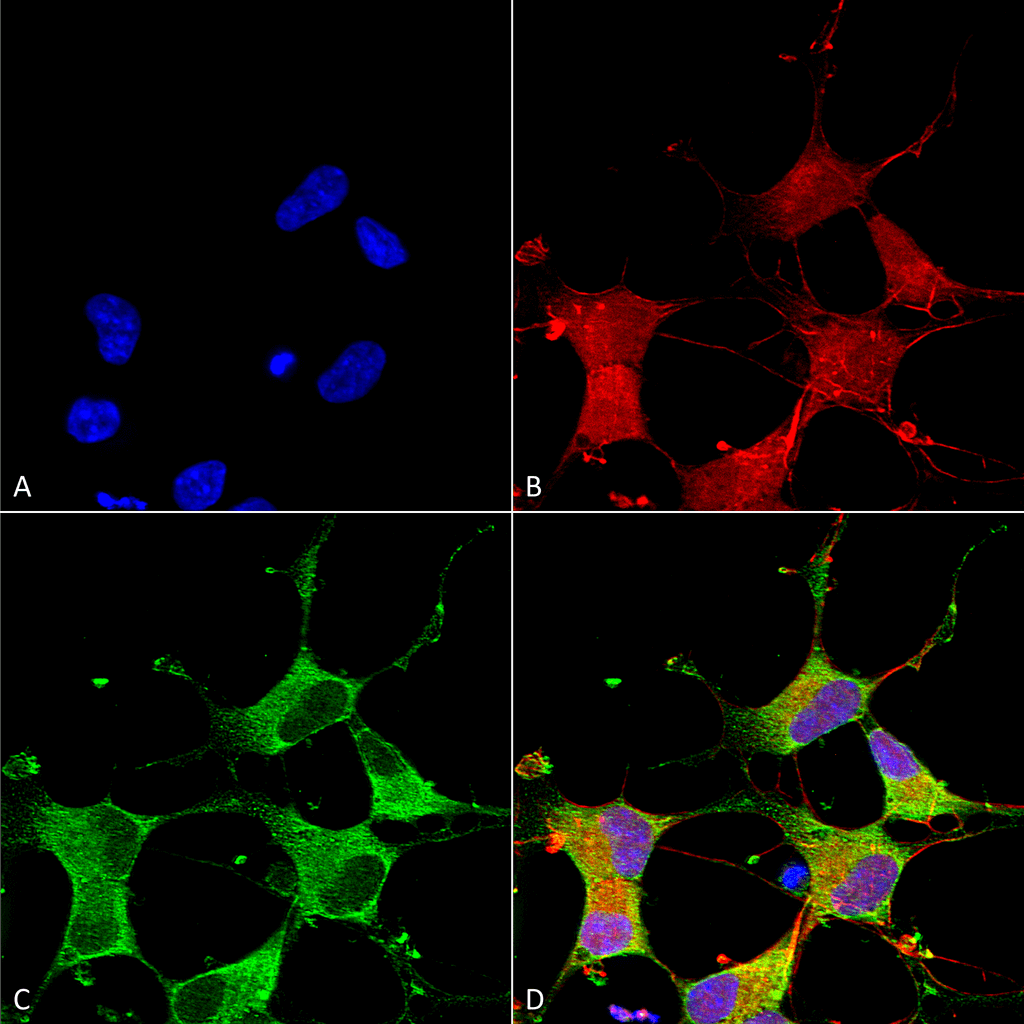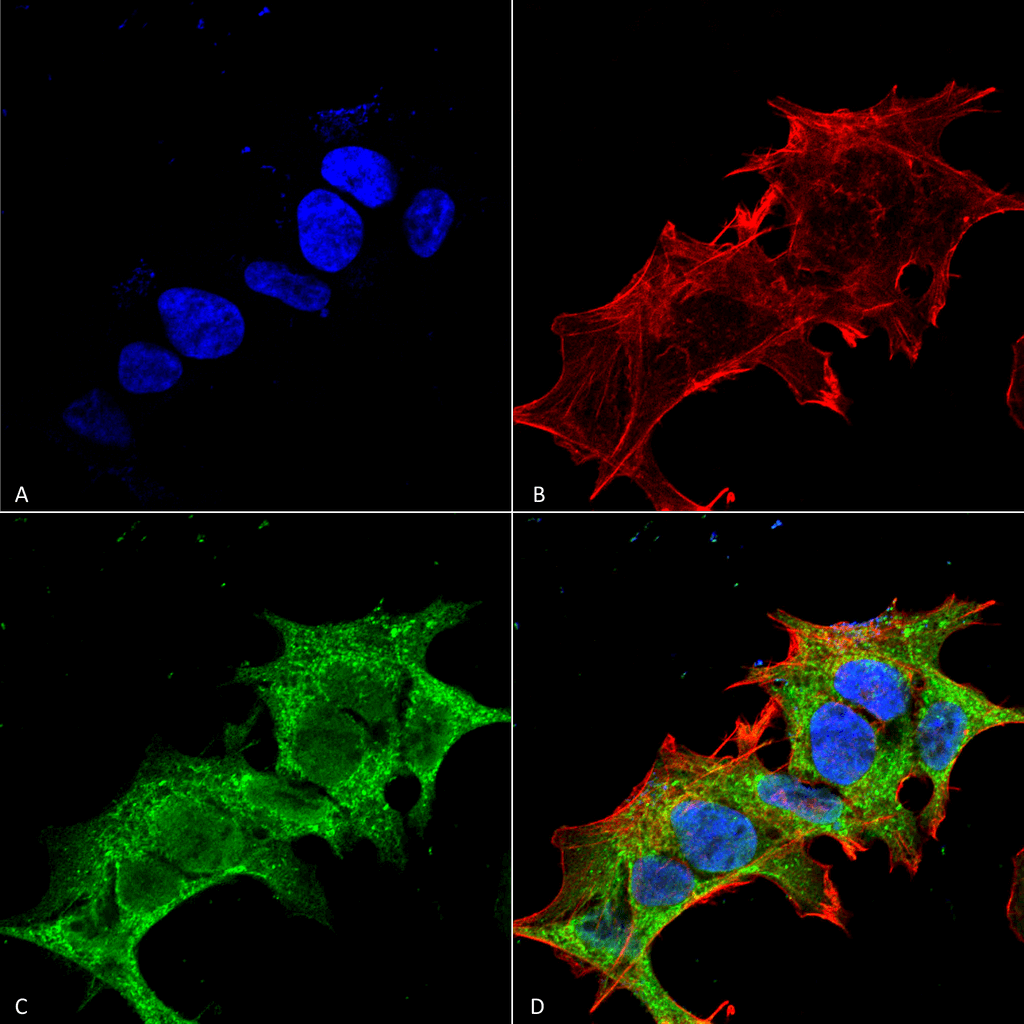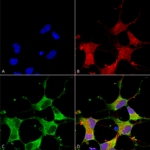Properties
| Storage Buffer | PBS pH7.4, 50% glycerol, 0.09% sodium azide *Storage buffer may change when conjugated |
| Storage Temperature | -20ºC, Conjugated antibodies should be stored according to the product label |
| Shipping Temperature | Blue Ice or 4ºC |
| Purification | Protein G Purified |
| Clonality | Monoclonal |
| Clone Number | N39B/8 (Formerly sold as S39B-8) |
| Isotype | IgG1 |
| Specificity | Detects ~90kDa. Does not cross-react with GIT2. |
| Cite This Product | StressMarq Biosciences Cat# SMC-413, RRID: AB_2701181 |
| Certificate of Analysis | 1 µg/ml of SMC-413 was sufficient for detection of GIT1 in 10 µg of rat brain lysate by colorimetric immunoblot analysis using Goat anti-mouse IgG:HRP as the secondary antibody. |
Biological Description
| Alternative Names | ARF GAP GIT1 Antibody, ARF GTPase-activating proteinAntibody, CAT1 Antibody, GRK-interacting protein 1 Antibody, ARF GTPase-activating protein GIT1 Antibody, Cool-associated and tyrosine-phosphorylated protein 1 Antibody, G protein-coupled receptor kinase-interactor 1 Antibody, GIT 1 Antibody |
| Research Areas | Cell Markers, Cell Signaling, Cytoplasmic Markers, Neuron Markers, Neuroscience, Phosphorylation, Post-translational Modifications, Scaffold Proteins |
| Cellular Localization | Cytoplasm |
| Accession Number | NP_114002.1 |
| Gene ID | 83709 |
| Swiss Prot | Q9Z272.1 |
| Scientific Background | G-protein coupled receptor (GPCR) kinase interacting proteins 1 and 2 (GIT-1 and GIT-2) are highly conserved, ubiquitous scaffold proteins involved in localized signaling to help regulate focal contact assembly and cytoskeletal dynamics. GIT proteins contain multiple interaction domains that allow interaction with small GTPases (including ARF, Rac and cdc42), kinases (such as PAK and MEK), the Rho family GEF PIX, and the focal adhesion protein paxillin (reviewed in 1). GIT-1 is localized to focal adhesions, cytoplasmic complexes and membrane protrusions, and regulates cell protrusion formation and cell migration (2). GIT-1 has also been implicated in neuronal functions including synapse formation (3) and the pathology of Huntington disease (4). Huntington disease is a genetic neurodegenerative condition involving a mutation in the huntington gene. The huntington gene product (htt) is ubiquitinated and degraded in human Huntington disease brains (5). Htt interacts directly with GIT-1 causing enhanced htt proteolysis, indicating that GIT-1 distribution and function may contribute to Huntington disease pathology (4). |
| References |
1. Hoefen R.J. and Berk B.C. (2006) J. Cell Sci. 119: 146 1475. 2. Manabe R., et al. (2002) J. Cell Sci. 115: 1497-1510. 3. Zhang H., et al. (2003) J. Cell Biol. 161: 131-142. 4. Goehler H., et al. (2004) Mol. Cell 15: 853-865. 5. Mende-Mueller L.M., et al. (2001) J. Neurosci. 21: 1830-1837. |
Product Images

Immunocytochemistry/Immunofluorescence analysis using Mouse Anti-GIT1 Monoclonal Antibody, Clone N39B/8 (SMC-413). Tissue: Neuroblastoma cells (SH-SY5Y). Species: Human. Fixation: 4% PFA for 15 min. Primary Antibody: Mouse Anti-GIT1 Monoclonal Antibody (SMC-413) at 1:50 for overnight at 4°C with slow rocking. Secondary Antibody: AlexaFluor 488 at 1:1000 for 1 hour at RT. Counterstain: Phalloidin-iFluor 647 (red) F-Actin stain; Hoechst (blue) nuclear stain at 1:800, 1.6mM for 20 min at RT. (A) Hoechst (blue) nuclear stain. (B) Phalloidin-iFluor 647 (red) F-Actin stain. (C) GIT1 Antibody (D) Composite.

Immunocytochemistry/Immunofluorescence analysis using Mouse Anti-GIT1 Monoclonal Antibody, Clone N39B/8 (SMC-413). Tissue: Neuroblastoma cell line (SK-N-BE). Species: Human. Fixation: 4% Formaldehyde for 15 min at RT. Primary Antibody: Mouse Anti-GIT1 Monoclonal Antibody (SMC-413) at 1:100 for 60 min at RT. Secondary Antibody: Goat Anti-Mouse ATTO 488 at 1:100 for 60 min at RT. Counterstain: Phalloidin Texas Red F-Actin stain; DAPI (blue) nuclear stain at 1:1000; 1:5000 for 60 min RT, 5 min RT. Localization: Cytoplasm . Magnification: 60X. (A) DAPI (blue) nuclear stain. (B) Phalloidin Texas Red F-Actin stain. (C) GIT1 Antibody. (D) Composite.


![Mouse Anti-GIT1 Antibody [N39B/8] used in Western Blot (WB) on Rat brain membrane lysate (SMC-413)](https://www.stressmarq.com/wp-content/uploads/SMC-413_GIT1_Antibody_N39B-8_WB_Rat_brain-membrane-lysate_1.png)




















Reviews
There are no reviews yet.